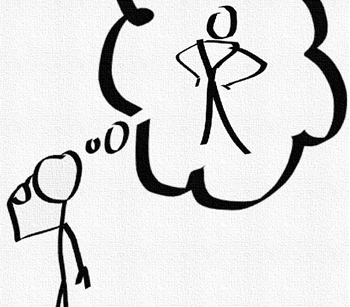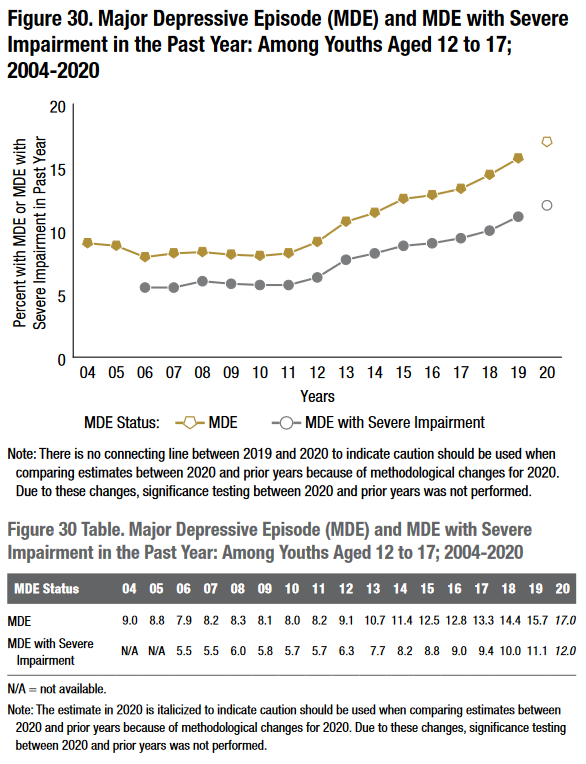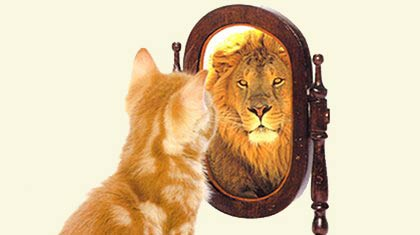Instilling Confidence in Adolescents
by Matthew Ajaj
February 7, 2022
When Adam and Eve ate the forbidden fruit, they were cursed with a sense of self-consciousness that made them embarrassed of their nakedness. Similarly, the hormone-fueled mental development that occurs in parallel to adolescence brings with it an often troublesome and unpleasant sense of self-awareness. Tweens and teens see themselves as part of perpetual play on a brightly lit stage, performing in front of astute audience whose gaze never wavers. Awkward and stressful as it may be, however, adolescence is a timeless phenomenon and a critical development period in our youth.
2020 National Survey of Drug Use and Health: MDE and MDE with Severe Impairment among Adolescents
And it is not getting any easier. Today’s adolescents are experiencing record levels of depression. The National Survey on Drug Use and Health (NSDUH)—an annual survey that has been conducted by the federal government for over 50 years—studies illicit drug use and mental disorders in Americans; it defines a person as having a major depressive episode if: “(1) they had at least one period of 2 weeks or longer in the past year when for most of the day nearly every day, they felt depressed, or lost interest or pleasure in daily activities; and (2) they also had problems with sleeping, eating, energy, concentration, self-worth, or having recurrent thoughts of death or recurrent suicidal ideation.” According to the 2020 survey, 17% of youths age 12-17 suffered from at least one major depressive episode within that past year—and 12% had an episode involving “severe impairment”—which is about double the rate in the same age group in the mid-late 2000s. The same study found that 12% of adolescents had serious thoughts of suicide, and nearly half of them had formulated a suicide plan. [1]
In interacting with the modern adolescent, you get the sense that they do not seem to have the same foothold on their lives as their past peers. They are more childish and yet less innocent, all at once incapable of navigating life’s challenges and yet warier of the world’s wickedness. More than ever before, they seem unsure of their place in society and of how they are supposed to grow up and manage the demands and responsibilities of adulthood in a rapidly transforming, unstable civilization.
Why is this happening to our youth? It is a complicated question, but certainly one major component of their precarious circumstances is their lack of self-esteem and confidence—two concepts that go hand-in-hand. Essentially, self-esteem is just confidence in oneself: it means liking who you are, self-affirming that you are worthy of other’s love and respect, and believing you are capable of tackling the challenges of life. Considering that lack of self-esteem is highly correlated to depression, it is no wonder that today’s youths are experiencing unprecedented levels of desolation. [2] Moreover, one does not need statistics to notice that adolescents are exhibiting mental illnesses and identity crises en masse—and both of these phenomena are directly correlated with low self-esteem. [3,4] Lack of confidence is definitely a culprit at play in adolescents’ plight—so what can you do as a parent to address it in your child?
1) Overcome Obesity – As discussed in a previous Well On Your Way article, childhood obesity is directly associated with low self-esteem and depression. According to recent data from the Center of Disease Control (CDC), now 1-in-5 children are obese—an increase of 25% compared to just 20 years ago and an increase of 400% compared to around 50 years ago. [5,6] The parent role necessitates taking on an active role in your child’s health to ensure they stay on the right path.
2) Prohibit Marijuana Usage – Marijuana decreases motivation, worsens concentration, increases risk of psychosis, and—despite the fact that many say otherwise—is an addictive substance. [7] The idleness induced by marijuana is antithetical to accomplishment, which is a vital component of self-esteem. According to the NSDUH, 10.1% of kids age 12-17 smoked marijuana in 2020, and of the 17% of youths that had a major depressive episode within the past year, 22% of them had smoked marijuana; compare that to the 83% of youths that did NOT have a major depressive episode in the past year, of which only 7.9% smoked marijuana. Therefore, the deduction can be made that smoking marijuana nearly tripled the risk of having a major depressive episode—or the inverse deduction can be made that having a depressive episode instigated marijuana use. The true answer may be a mixture of both. Regardless, the strength of the correlation between smoking marijuana and depression in adolescents cannot be ignored.
3) Offer Independence – This may be the default for some parents, and may be much for difficult for others. While it is important to embrace a more authoritarian role when your child goes down the road of unhealthy habits like poor eating habits and drug use, it is nonetheless vital to offer them independence in other avenues. Just as a caged bird will never learn to fly, an adolescent will never develop confidence if they are never allowed to do anything on their own. As long as they are not perched over a cliff, trials of independence are beneficial (and necessary) for development.
4) Encourage Skill Acquisition – In order for adolescents to feel good about themselves, they obviously need something which they can feel good about—and there is arguably no better way to do that than to acquire a skill that is useful and/or appreciated by others. Useful skills for adolescents may include car repair, sewing, cooking, woodworking, fishing, and gardening. As for admirable skills, one excellent example would be learning an instrument; there may be nothing quite as confidence-building as your child being able to play a beautiful piece on a piano. Athletic skills gained from playing sports are another great example, as they are not only admirable but advancement of bodily ability and coordination will satiate your adolescent’s biological drive for physical prowess.
5) Dress for Success – Dressing well pays dividends. Your child being able to look themselves in the mirror and have satisfaction in their appearance is a core component of self-esteem. Most teen girls are able to grasp this concept on their own, but teen boys may struggle to grasp this (I know I did). Instead of letting your son waltz into school every day with a football jersey or stained T-shirt or gym shorts or even pajama pants (yikes), encourage him to try on a polo or nice flannel with jeans or khakis and a belt. And maybe remind him to shave regularly instead of walking around with an awkward stubble. While they might be reluctant to take the extra few minutes to take care of themselves on a daily basis, it will not take long for them to notice that looking good leads to feeling good.
6) Tell Them Hit the Gym – The gym can be intimidating for a newcomer, but it is well worth the trip. Trimming fat and building muscle are superb confidence boosters. Working out also works in tune with our biological drive to reach peak physical fitness; there’s a reason why it feels great!
7) Be a Role Model – Your adolescent will not be motivated to watch their diet, hit the gym, avoid drugs, develop skills, dress for success, and maintain personal hygiene if you are not doing the same. Your child is made from your genes, after all; show them what they are capable of.
In this chaotic era where adolescents find themselves in the increasingly precarious position of uncertainty on who they are and what they will become, they need a stabilizing force to keep their footing; this is where the parents need to step in. Every loving parent wants to kindle their kin into young adults who are capable of overcoming adversity, forming families, and finding success and fulfillment; the hard part is figuring out how exactly to kickstart your child’s developmental engine in the first place. The key to the ignition is confidence. Before an adolescent can grow into an amazing adult, they first need to like themselves, see worth in themselves, and believe themselves to be a competent individual. Self-esteem is the foundation adolescents are built upon to become strong, stable, and capable adults. Fuel them with confidence, and your adolescent will be well on their way!
* * *
Citations
[1] Substance Abuse and Mental Health Services Administration. (2021). Key substance use and mental health indicators in the United States: Results from the 2020 National Survey on Drug Use and Health (HHS Publication No. PEP21-07-01-003, NSDUH Series H-56). Rockville, MD: Center for Behavioral Health Statistics and Quality, Substance Abuse and Mental Health Services Administration. Retrieved from https://www.samhsa.gov/data/
[2] Masselink M, Van Roekel E, Oldehinkel AJ. Self-esteem in Early Adolescence as Predictor of Depressive Symptoms in Late Adolescence and Early Adulthood: The Mediating Role of Motivational and Social Factors. J Youth Adolesc. 2018;47(5):932-946. doi:10.1007/s10964-017-0727-z
[3] Guillon MS, Crocq MA, Bailey PE. The relationship between self-esteem and psychiatric disorders in adolescents. Eur Psychiatry. 2003;18(2):59-62. doi:10.1016/s0924-9338(03)00002-6
[4] Akdemir D, Çak T, Aslan C, Aydos BS, Nalbant K, Çuhadaroğlu-Çetin F. Predictors of self-esteem in adolescents with a psychiatric referral. Turk J Pediatr. 2016;58(1):69-78. doi:10.24953/turkjped.2016.01.010
[5] CDC. Childhood Overweight and Obesity. Centers for Disease Control and Prevention. Published August 30, 2021. https://www.cdc.gov/obesity/childhood/index.html
[6] Products - Health E Stats - Overweight Among Children and Adolescents, 1999-2002. Published 2019. https://www.cdc.gov/nchs/data/hestat/overweight/overweight99.htm
[7] Sadhana Dharmapuri, Kathleen Miller, Jonathan D. Klein; Marijuana and the Pediatric Population. Pediatrics August 2020; 146 (2): e20192629. 10.1542/peds.2019-2629




